August 26, 2015 – Volume 17, Issue 2: The Dalai Lama on Climate Change
In This Issue
Flanigan’s Eco-Logic
What do Fukushima, Block Island, and Cuba Have in Common?
Windpower Monthly’s Top 10 Largest Wind Turbines
Get Ready for Hybrid Houses
U.S. Conference of Mayors Awards…Solar Santa Monica
EcoMotion Welcomes New Staff
Natural Gas Generation Surpasses Coal
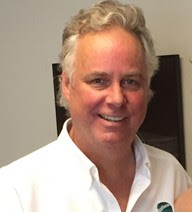
Flanigan’s Eco-Logic: The Dalai Lama on Climate Change
The invitation came from Teri Osbourne at Santiago High School in Garden Grove. She’s “the APES teacher” there, Advanced Placement Environmental Studies. “You guys want to come with us to see the Dalai Lama speaking on climate change?” Sure, University of California at Irvine Bren Center here we come.
Never a dull moment in life. Today it’s the 14th Dalai Lama’s Global Compassion Summit on the Effects of Climate Change. We head into “the OC” (Orange County), to UCI, and park near massive solar arrays, stark superstructures on this grey day. Protestors beat drums, shout in megaphones, and litter the crowd with paraphernalia. They claim that the Dalai Lama is a fake, a lie, and not to be trusted.
A few weeks earlier the Pope pontificated on climate. He gave an “environmental encyclical,” a 182-page statement about our moral imperative to protect our planet, our home. Now the Dalai Lama speaks out on his 80th birthday. It’s all about compassion.
University of California at Irvine was recently rated the number one green university in the nation for the second year in a row. UCI was founded in 1965 and is now 50 years old. Its Bren Event Center is surprisingly spacious and calm. We listen to musicians and Hopi dancers and anticipate the event.
The main session begins rather spontaneously. The session moderator – Ann Curry — informs the audience about what’s taking place on stage. She jokes that His Holiness does not follow protocols. Look, she waves, he’s just headed out on stage before his queue and can now be seen milling about in the shadows! We hear chuckles from his live microphone. He’s mischievous.
University of California Regent Richard Blum, Diane Feinstein’s husband, introduces “His Holiness.” As a climber in Tibet, Blum met the Dalai Lama years ago. He’s considered the Dalai Lama a friend every since. His Holiness prays for five hours a day, channeling his own energy, perhaps all one can really do. Through HH’s interpreter we learn an old Tibetan expression, basically that you have to heal the chancre sore in your own mouth to be able to heal the planet.
The Dalai sits back. He’s respectful of all and clearly playful. He jokes around, purposefully breaking protocol. He interrupts the program to pay great respect to his elder on stage, the 97-year old oceanographer Walter Munk who still works seven days a week to raise awareness about the perils of climate change. The Dalai Lama makes him share his oversized chair, holds his hand, and fondly leans his head on his shoulder. Munk has a huge grin on his face throughout. He has a new bud.
On climate, the Dalai Lama does not bother with, nor is phased by, technical details, only the big picture. He let’s the experts shine with solutions. And all the Dalai Lama sees are solutions to climate protection. He is optimistic and relevant: He believes that California’s water shortage can be eliminated with desalinization driven by solar power. He sees a future for California with many more trees and much more agriculture. He envisions a bright future. All we need is to exercise compassion.
It’s hard to understand each word that His Holiness utters. He has a thick dialect, a reserved voice, and a somewhat limited English capacity. But one quickly senses his warmth, soul, and sense of duty. In 1940 he was enthroned; by 1950 he assumed full political control of power in Tibet. Then the Tibetan region was taken over by the Chinese Communists in 1959. Monks were jailed, their monasteries pilloried, and their traditions chastised. Those that could sought religious freedom in northern India. Dharamshala became the home of the Dalai Lama in exile.
Ann Curry, former NBC Today Show host, is a moderator extraordinaire, charming and respectful. She lobs friendly questions to each the UCI Chancellor, a Board of Regents member, three faculty members, and U.S. Congressman Loretta Sanchez. They reinforce His Holiness’s perspective: Climate action is not bound by technical limits. Instead the panelists all agree that the issue is one of faith. To survive and thrive, our religious and spiritual leaders need to lead. We must turn to compassion and scale, deploy, and share solutions.
Similarly, several speakers said that it’s not about protecting one’s country, but putting the global society first. The interconnectedness is revealed by sea levels rising, reportedly as much as a meter in our lifetimes. We are comforted by activist Mia Yoshitani’s vision, a vision that she says is far greater than the threat at hand… a vision for a better society, a more loving society.
The session ends with a fitting tribute. U.C. San Diego professors including panelist Veerabhadran Ramanathan are studying the state of the planet deep at sea. There, they are finding and researching new organisms. Recently they decided to name a newly discovered marine species after the Dalai Lama… the “Sirsue Dalailamai.” Why? It gives more than it takes. Like the Dalai Lama, its existence on Earth is truly net positive.
And here at UCI, on his 80th birthday, and as usual we understand, Ann Curry makes clear that he has given each of us much more than he took, filling our souls with a bit of levity, decency, and compassion for each other and all global citizens.
Quote of the Week
What do Fukushima, Block Island, and Cuba Have in Common?

Fukushima, Source: Wind Power Monthly
All are focused on wind power, the fastest growing source of generating capacity in America. According to the U.S. Department of Energy, the cost of wind energy has fallen 65.5% since 2009. Inversely, wind power capacity has grown by an average of 25.8% each year for the past 10 years. By the end of 2014, there was a total of 65,879 MW of U.S. wind energy capacity, enough to power 18 million American homes.
There’s a wind farm being established 12 miles off the coast of Fukushima, Japan. Since the nuclear accident there, offshore wind has garnered a lot of support. The Fukushima Wind Project is being managed by Marubeni, funded by the Japanese government, with research and support from University of Tokyo and Mitsubishi Heavy Industries. Hitachi has supplied 2 and 5 MW wind turbines for the floating project.
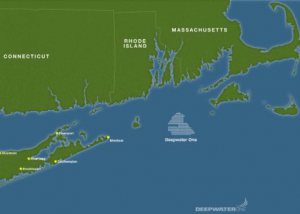
Map of the Block Island Wind Farm
The Block Island Wind Farm off Rhode Island’s coast is the first of a generation of American offshore projects. Fully, 11 U.S. offshore wind projects with a combined capacity of 2,500 MW located in 10 states are at varying points of development. Deepwater Wind of Providence, Rhode Island is developing the five-turbine, Block Island Wind Farm. Work began in April of this year after seven years of planning and permitting. At 589 feet above sea level, the turbines will be among the tallest in the world. Each of the Alstom wind turbines to be used there is rated at 6 MW; total annual production will be more than 100 million kWh.
Deepwater Wind is constructing the wind farm about three nautical miles southeast of Block Island and will directly provide for the island’s power. Deepwater Wind will sell the electricity through a power purchase agreement to National Grid, a Rhode Island utility. Because the island uses only one megawatt of power in the off season and four megawatts in the summer peak season, the balance of power will be sent to other customers via a 25-mile bi-directional submerged transmission cable between Block Island and the Rhode Island mainland.
Given the lack of experience with offshore wind farms, Deepwater recruited a Louisiana firm that specializes in offshore oil and gas industry to fabricate the lattices making up the 1,500-ton, turbine foundations. The farm is due to go operational in fall of 2016 and is expected to lower electricity prices for Block Island residents by about 40%.
Cuba also has lofty aspirations for this renewable resource. It currently has four wind parks with a combined capacity of 12 MW. Renewables in Cuba now account for slightly more than 4% of the island nation’s generation electricity. Cuba plans to build 13 wind farms, including seven facilities financed with foreign investments. Wind power is an integral part of Cuba’s goal to source 24% of its power from renewable energy sources by 2030.
Windpower Monthly’s Top 10 Largest Wind Turbines
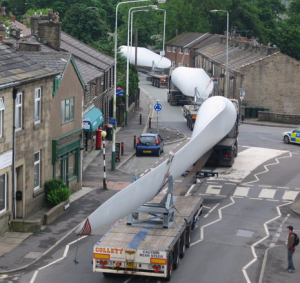
Turbine convoy makes its way through the UK
Wind turbines are getting massive, especially those being deployed offshore. As this article presents, there are now turbines being tested that are as large as 8 MW in size with even larger ones on the drawing boards. Most of these have been developed for offshore locations. And some like those being deployed at Fukushima float, making deployment in deep water a reality.
Just as wind energy’s cost has been reduced over time, turbine manufacturers have increased their size for economic and environmental reasons. The following compilation is from Windpower Monthly:
The 8 MW Vestas V164 is the largest wind turbine currently available. With 80 meter-long blades and a lightweight nacelle, it began testing in January 2014 at the Danish National Wind Turbine Test Centre at Osterild. Second largest is the 7.5 MW Enercon E126 designed for onshore locations. Currently, 34 of these units are operational.
Third largest is Samsung’s 7 MW turbine which has been built as a prototype at a test site in Scotland. It features the world’s longest turbine blade at almost 85 meters. Reportedly this machine is unlikely to go into production following Samsung’s 2014 move to exit the offshore wind industry.
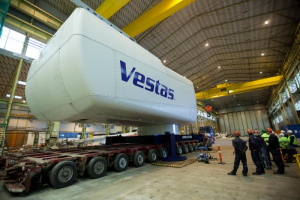
The nacelle of the Vestas 8MW turbine
Fourth is the 7 MW, MHI SeaAngel that was installed in Scotland in early 2015. Given the MHI joint venture with Vestas, it is also unlikely to go into full-scale production. Experts say that SeaAngel’s hydraulic drive train may be passed on to the V164 at a later date.
Repower ‘s 6.2 MW onshore/offshore turbine is fifth on the list and currently the largest turbine installed on the open sea, building on the success of its 5 MW predecessor used in a number of North Sea and Irish Sea projects. The turbine’s rotor width is 126 meters and its offshore tower height is 85 – 95 meters. Number 6 is the 6 MW Siemens offshore machine that exists as an onshore prototype. Its 3.6 MW predecessor is generally regarded as the best turbine in the offshore sector.
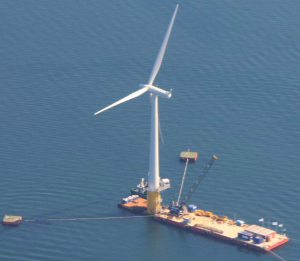
The Siemens turbine going through R&D
Number seven on the list is Alstom ‘s Haliade. It is currently being tested in France. The 6 MW turbine is set to form the bulk of France’s 3 GW offshore program and uses a direct-drive permanent-magnet generator with a 7.5-meter diameter. Eighth largest is Sinovel ‘s 6 MW turbine that is currently being tested in China where it is the country’s largest wind turbine. The turbine has a 128-meter diameter rotor, has been tested at -45 degrees Celsius, and also has low-voltage, ride-through capacity necessary for Chinese wind farms. Sinovel is now designing a 10 MW machine.
The 5 MW Areva M5000 is number nine on the list and currently operates in the German North Sea. It is planned for a French offshore projects in the English Channel. Of similar size, Gamesa’s 5 MW turbine is tenth largest and is currently being tested in Gran Canaria. It is designed for near-shore areas but its relatively light weight means the machine can use a monopile foundation in water depths of up to 35 meters.
Get Ready for Hybrid Houses
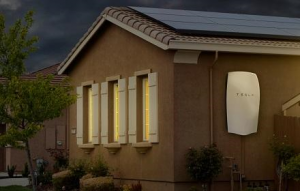
Source: Solar City
Just as many of us are getting comfortable with the notion of hybrid cars, we now have hybrid houses. Soon our homes, just like our hybrid cars, will get power from both a primary and secondary source, the latter likely in the form of a lithium-ion battery. Get ready! Got a hybrid house yet? Why not?
Tesla’s PowerWall announcement certainly made waves. While there are over a dozen companies promoting “advanced energy storage” solutions (mostly for business customers that pay demand charges), Elon Musk’s April 30 announcement raised a lot of public attention. These are the hottest “appliances” to hit the market since horizontal-axis washers. Bolt them to the garage wall, and get ready to ignore them. And stay tuned for 100 kW PowerPacks for businesses.
There’s a lot of merit in distributed storage. And there’s a lot of hype flying around! But while the PowerWall battery banks are sleek and relatively low cost, most consumers likely do not understand how they work. Their limited storage amount does not allow customers to disconnect from the grid altogether. That would require much larger batter banks, and would be prohibitively expensive.
Tesla’s marketing push suggests 7 and 10 kWh systems for $3,000 – $3,500. That’s before installation and the purchase of an inverter. Those prices seem reasonable given $10,000 – 15,000 to purchase a typical residential solar system. So sure, they may soon be a cost-effective complement to one’s solar system and electric vehicle. So are they worthwhile? A rather sophisticated load profile analysis may be required to do the math.
The advantage of hybrid houses is economic: Excess solar generation can be stored for later uses. But even more financially attractive, low-cost energy can be purchased from the grid at night and stored, and then discharged (used) when grid power is most expensive. As time of use rates spread across the residential sector, offsetting the highest of these rates is more and more appealing.
Bigger battery systems are being used to cut demand charges in industry and for business customers that face ratcheting demand charges, and increasingly longer summer peak periods. EcoMotion has introduced “advanced energy storage” to school district clients, primarily as demand charge reduction strategies. Batteries also support microgrids that can be autonomous and resilient to power outages.
In summary, Tesla’s announcement is a harbinger of things to come. Storage will indeed play a bigger and ever-more important role in power systems of the future. We now prepare for “DS” to complement “DG,” “distributed storage” to complement “distributed generation.” The roll-out of DS, however, will be a complex function of avoided peak power prices and demand charges set by our regulators
U.S. Conference of Mayors Awards Solar Santa Monica
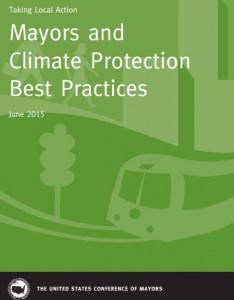 The U.S. Conference of Mayors honored Santa Monica on June 19th in San Francisco with a U.S. Mayors’ Climate Protection Award for its successful Solar Santa Monica initiative. Solar Santa Monica has helped Santa Monica residents and businesses convert their homes and commercial buildings to solar power for over eight years.
The U.S. Conference of Mayors honored Santa Monica on June 19th in San Francisco with a U.S. Mayors’ Climate Protection Award for its successful Solar Santa Monica initiative. Solar Santa Monica has helped Santa Monica residents and businesses convert their homes and commercial buildings to solar power for over eight years.
EcoMotion has served as the City’s solar consultant since Day 1 of the program… for over eight years. We designed the Solar Santa Monica program, developed the brand, have provided household and business assessments, have worked with the College, and the school district. One summer we fielded a “Solar Squad” that hit the streets mapping the best homes for solar. The Squad visited over 5,000 houses, and had over 1,000 solar discussions with homeowners.
“Santa Monica is being recognized because we’ve done more than just study climate change – we’ve taken action to slow it, and to protect our community from the impacts,” said Mayor Kevin McKeown. With less than 1% of the City’s solar potential tapped, in the City decided to create a program to stimulate installations, to help home and business owners, as well as the college, schools, and all others to invest in solar.
Solar Santa Monica was created by the City in 2006 to stimulate combinations of energy efficiency and solar energy throughout the community. The City offers technical assistance to prospective residents and businesses by evaluating solar potential, navigating regulatory and rate changes, identifying financial mechanisms, vetting contractors, and evaluating bids. In its first year, Solar Santa Monica doubled solar capacity in the City.
Since the program inception, Santa Monica has seen solar capacity increase twelve-fold from 376 kW to 4,656 kW, enough energy to power over 1,170 California homes. To date, community-installed solar has reduced annual emissions by 2,584 MTCO2e (equivalent of the average car circling the earth 267 times), helping the City of Santa Monica achieve its 2015 target of reducing city-wide emissions by 15% from the 1990 baseline.
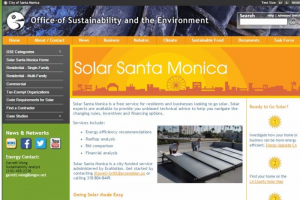 Solar Santa Monica exemplifies how Santa Monica’s Office of Sustainability and the Environment helps to connect residents and businesses with smart energy solutions. The program provides comprehensive services for residents, businesses, and academic institutions go solar by reducing the anxiety and risk to the prospective consumer. The prevalence of solar technology throughout the community has continued to reinforce Santa Monica’s commitment to being a leader in sustainability. The result is Solar Santa Monica is a valued resource and recognizable brand in the community.
Solar Santa Monica exemplifies how Santa Monica’s Office of Sustainability and the Environment helps to connect residents and businesses with smart energy solutions. The program provides comprehensive services for residents, businesses, and academic institutions go solar by reducing the anxiety and risk to the prospective consumer. The prevalence of solar technology throughout the community has continued to reinforce Santa Monica’s commitment to being a leader in sustainability. The result is Solar Santa Monica is a valued resource and recognizable brand in the community.
“We’re excited that this program was recognized by the U.S. Conference of Mayors because it has been wildly successful here in Santa Monica and is a great model for other cities to follow,” said Dean Kubani, who manages the Office of Sustainability and the Environment for the City. “It’s a good example of how local governments can kick-start sustainable actions in the community that provide multiple benefits for everyone.” Visit www.SolarSantaMonica.com or contact EcoMotion for more information..
EcoMotion Welcomes New Staff
EcoMotion is pleased to announce and to welcome two new staff:
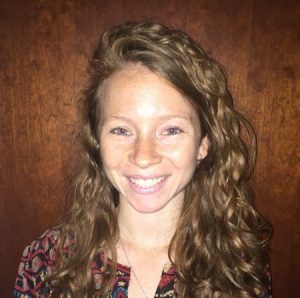 Emily Schweitzer brings a strong background in student engagement and leadership development to EcoMotion campus clients. As a student at Clark University, Emily founded and headed the Ecological Representatives (Eco-Reps) and Ecological Volunteers (Eco-Teers) programs and later served asthe Campus Organizer for Power Shift 2009. Building off of this momentum, Emily brought the Leadership Campaign to Worcester schools, generating robust student-led movements on three universities advocating for bold climate change policy in Massachusetts, involving sleep-outs on the Boston Commons and lobbying of local officials.
Emily Schweitzer brings a strong background in student engagement and leadership development to EcoMotion campus clients. As a student at Clark University, Emily founded and headed the Ecological Representatives (Eco-Reps) and Ecological Volunteers (Eco-Teers) programs and later served asthe Campus Organizer for Power Shift 2009. Building off of this momentum, Emily brought the Leadership Campaign to Worcester schools, generating robust student-led movements on three universities advocating for bold climate change policy in Massachusetts, involving sleep-outs on the Boston Commons and lobbying of local officials.
At EcoMotion, Emily serves as the Campus Sustainability Coordinator and is organizing sustainability efforts on campuses, and assisting in student engagement efforts, sustainability projects, and program development. In her free time she can be found running outside (weather permitting), shopping at farmers markets, and face timing with her brother. Emily holds a B.A. in Global Environmental Studies and an M.A. in International Development and Social Change, both from Clark University in Worcester, Massachusetts.
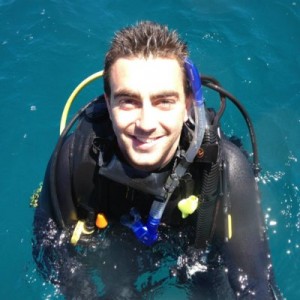
Ben Meissner has joined our California team as an intern. Ben hales from Bethesda, Maryland. In 2014, Ben graduated from University of Southern California with a degree in Business Administration from the Marshall School of Business, and a minor in screenwriting in the School of Cinematic Arts. Ben has a passion for media production as it relates to the contemporary issues of the global society.
At USC, Ben was the Social Chair of the Men’s Rugby team. After graduating, he spent eight months as a scuba divemaster in Khao Lak, Thailand. Ben will now be supporting EcoMotion’s sustainability works with an emphasis on business management and social media. Thanks to Russ Sturm of the International Finance Corporation for the introduction.
